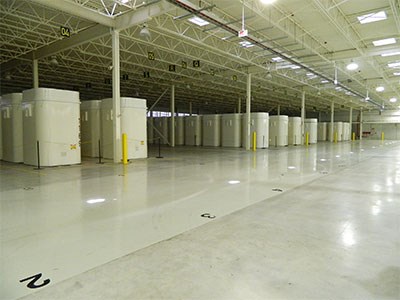Four Northern Ontario communities are in the running to potentially host a deep underground repository for Canada's nuclear waste.
“The communities of Elliot Lake, Blind River, Manitouwadge and White River were assessed as having strong potential to meet the site selection requirements of the APM (Adaptive Phased Management) initiative and have been identified for further study,” said the Nuclear Waste Management Organization, which was created in 2002 to manage waste from Canada's nuclear reactors.
The communities of Spanish and North Shore were not chosen for further study.
The four Northern communities still in the running volunteered to participate in an extensive process that could extend to decades.
The Nuclear Waste Management Organization has started field investigations and expanded engagement in each community – which is the third step of a nine-step process, that would culminate with the construction of a 500-metre repository for two million half-metre cylindrical bundles that contain radioactive uranium dioxide pellets.
“If everything goes well, the very earliest that the project would be operational is 2035,” said Michael Krizanc, a spokesperson for the Nuclear Waste Management Organization.
During a 10-year construction period, the project would create around 1,000 jobs.
Its 40-year operation period would support 600 to 800 jobs – ranging from maintenance to security – and an extended monitoring period would create a smaller number of jobs for more than 100 years.
“It's not a resource industry that's based on the vagaries of the commodities market,” said Krizanc. “The jobs can't be outsourced to Mexico.”
For a city like Elliot Lake, which had to reinvent itself after its last uranium mine closed in the mid-1990s, the potential for hundreds of long-term, and high-paying jobs has created an attractive incentive to involve itself with the project.
“It's not just an economic benefit for Elliot Lake. There's an economic benefit for the whole region,” said Elliot Lake Mayor Dan Marchisella. “The surrounding communities will all feel the effects of that as far as employment.”
But the potential for a local nuclear waste repository has not been without its controversy in the small city.
Marchisella said about a quarter of Elliot Lake's citizens have expressed concern around the project.
“They hear 'nuclear waste' and they envision these big barrels full of toxic waste rolling through town on the back of pickup trucks,” he said.
But Krizanc said the reality of nuclear waste management is far from people's fears.
Canada's nuclear reactors currently cool used bundles in pools of water called used fuel bays for at least 10 years.
“When used fuel comes out of a reactor it is highly radioactive,” Krizanc said.
But after one year, about 99 per cent of the radioactivity has dissipated.
At that point the bundles are moved from the used fuel bays into robust concrete and steel containers, and stored in large warehouses on the station site. Although these containers are designed to last at least 50 years, they're not a permanent solution.
“Canadians were very clear that our generation, which created this waste, has a responsibility to put in place a long-term waste management system,” said Krizanc.
Once the nuclear waste is removed from the used fuel bays, it still takes several hundred years before the radioactivity is so low that a person would need to ingest the material to get sick.
A deep geological repository would include multiple barriers, including the surrounding rock, which would ideally be solid granite.
The used fuel bundles would likely be transported to the site by truck or rail, Krizanc said.
“We are confident that used nuclear fuel can be safely transported,” he said.
To transport used nuclear fuel the Nuclear Waste Management Organization uses specially designed 30-tonne storage containers.
The containers are made of solid steel, with no seams or welds, and the walls are about 12 inches thick.
The 30-tonne containers are designed to carry five tonnes of used nuclear fuel.
“The actual container weighs six times more than the payload,” Krizanc said. “It's extremely robust.”
In safety tests, the containers have survived explosions and a head-on collision with a speeding locomotive, with only a few scratches to show after the impact.
Elliot Lake has identified three potential sites for an underground repository. The closest is 50 kilometres from the city, and the furthest is 90 kilometres away.
If the city makes it to the fourth step of the Nuclear Waste Management Organization it would enter detailed site evaluations – to determine their geological and environmental suitability for a repository – at a cost of around $200 million.
Only one or two communities are expected to advance to that stage.
Even after the $200-million investment, the communities are free to drop out of the process.
From start to finish – the project is expected to cost $6 billion to $8 billion in today's dollars, or roughly $16 billion to $24 billion, taking inflation into account, by the time the repository is completed.
Canada's nuclear power producers have created trust funds to cover the project's costs. To date those funds have collected around $3 billion.
In Ontario, about one tenth of a cent per kilowatt-hour goes towards the trust funds.




